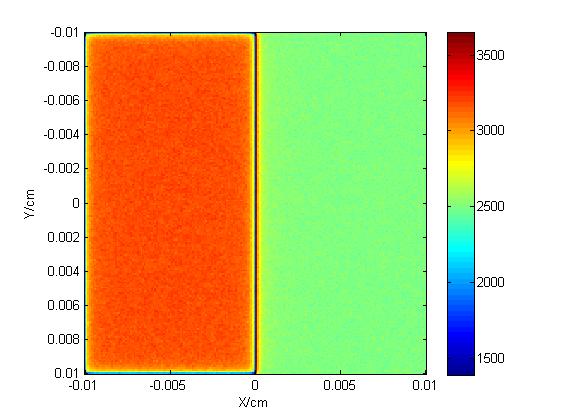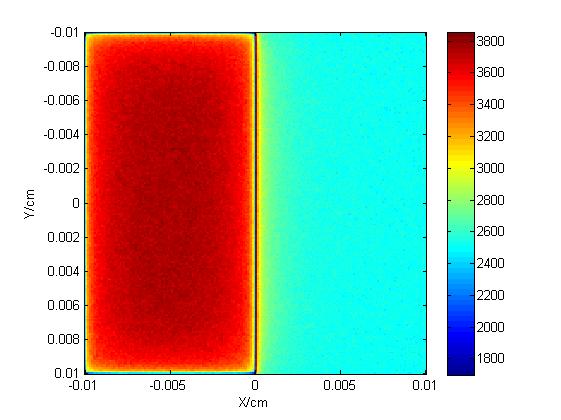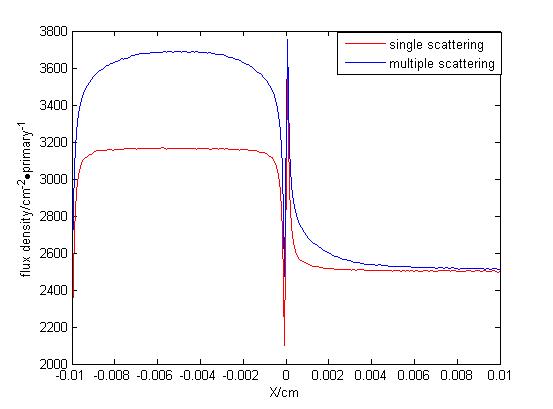Date: Thu, 20 Feb 2014 10:52:32 +0800 (CST)
Dear Professor Albert,
Thanks for your detailed reply.I am trying to see the difference between multiple scattering and single scattering when the target is thin or the target is like the schematic plot in the attachment.
1)the target is defined as an RPP which is not symmetric in x and y, and
> is 1 um long in the z direction:
> RPP tan -0.01 0.0 -0.01 0.01 0.0 0.0001
> i.e.: x from -100 um to 0.0
> y from -100 um to +100 um
> z from 0.0 to 1 um
why x different from y?
My answer:To tell the truth,I set the target optionally.I just think about the taget thickness along the z direction.By the way,Is there a problem when I set x different from y?
2) the beam is directed along z, and is 200 um wide on both x and y
> direction:
> BEAM -2.E-5 0.02 0.02 ELECTRON
> therefore, half of the beam (from x=0.0 to x=100 um) does not hit the
> target. Why?
My answer:This is a problem.I will correct.
3) The only scoring is electron fluence in a USRBIN as follows:
> 200 bins in x from -100 um to 100 um
> 200 bins in y from -100 um to 100 um
> 1 bin in z from 0.0 to 1 um
> But the plot you sent looks like being in the z direction. Totally
> inconsistent with the USRBIN.
My answer:Using USRBIN card,I can get a two-dimensional fluence figure(you can see it from the attachment).When I sum the fluence along the y direction,and then calculate the mean value,I can get the figure of flux density.In the attachment,I give two-dimensional fluence figure(both multiple scattering and single scattering).
4) There is a transport cutoff, but not a production cutoff.
> You should have both. You can use the same limits (but remember that
> production cutoffs are give by material and not by region)
My answer:This is a problem.I will correct it.
5) You have attached an input for single scattering, but not one for
> multiple scattering
My answer:This time,I have attached an input for multiple scattering.
6) With such a thin target, multiple scattering would always be switched
> off automatically for single scattering, because all steps would be too
> short for Moliere's theory. So, you should see no difference at all
> between the two options. See at the end of output the statistics of
> such switchings
My question:You said for such a thin target,multiple scattering would always be switched off automatically for single scattering.Now,if I have a target like the schematic plot in the attachment,the red part of the schematic plot is 1 um along the z direction.For such a target,what kind of scattering should I use? Likewise,the result(the flux density) I got is different from multiple scattering to single scattering.
Best Regards
Chen Yuan
> -----Original E-mail-----
> From: "Alberto Fasso" <fasso_at_mail.cern.ch>
> Sent Time: 2014-2-19 22:00:03
> To: "fluka-discuss_at_fluka.org" <fluka-discuss_at_fluka.org>
> Cc: "yyc2011_at_mail.ustc.edu.cn" <yyc2011_at_mail.ustc.edu.cn>
> Subject: the comparision of Multiple Scattering cross section and Single Scattering cross section
>
> Dear Chen Yuan,
>
> your attachments do not help me to understand what you are trying to do.
> There are several strange things.
>
> 1) the target is defined as an RPP which is not symmetric in x and y, and
> is 1 um long in the z direction:
> RPP tan -0.01 0.0 -0.01 0.01 0.0 0.0001
> i.e.: x from -100 um to 0.0
> y from -100 um to +100 um
> z from 0.0 to 1 um
> why x different from y?
>
> 2) the beam is directed along z, and is 200 um wide on both x and y
> direction:
> BEAM -2.E-5 0.02 0.02 ELECTRON
> therefore, half of the beam (from x=0.0 to x=100 um) does not hit the
> target. Why?
>
> 3) The only scoring is electron fluence in a USRBIN as follows:
> 200 bins in x from -100 um to 100 um
> 200 bins in y from -100 um to 100 um
> 1 bin in z from 0.0 to 1 um
> But the plot you sent looks like being in the z direction. Totally
> inconsistent with the USRBIN.
>
> 4) There is a transport cutoff, but not a production cutoff.
> You should have both. You can use the same limits (but remember that
> production cutoffs are give by material and not by region)
>
> 5) You have attached an input for single scattering, but not one for
> multiple scattering
>
> 6) With such a thin target, multiple scattering would always be switched
> off automatically for single scattering, because all steps would be too
> short for Moliere's theory. So, you should see no difference at all
> between the two options. See at the end of output the statistics of
> such switchings.
>
> Alberto
>
>
>
>
> On Tue, 18 Feb 2014, yyc2011_at_mail.ustc.edu.cn wrote:
>
> > Dear Professor Alberto,
> >
> > I am very sorry for my many times asking.But,the result I got is really
> > different.Please look at my attachment.In the input file,the incident
> electron
> > energy is 20 KeV and the carbon target is 1 um.You can see from the
> figure of
> > flux density;the results differ from multiple scattering to total single
> > scattering.I think the difference is big,not minimal.What is your
> opinion?
> >
> > Thanks for your guidance.Thanks for your reply.I'm very grateful to
> you.
> >
> > Best Regards
> > Chen Yuan
>
- application/octet-stream attachment: rl_single_scattering_.inp

(image/jpeg attachment: two_-dimensional_fluence_figure_single_scattering_.jpg)
- application/octet-stream attachment: rl_multiple_scattering_.inp

(image/jpeg attachment: two_-dimensional_fluence_figure_multiple_scattering_.jpg)

(image/jpeg attachment: the_figure_of_flux_density.jpg)
- application/pdf attachment: schematic_plot.pdf